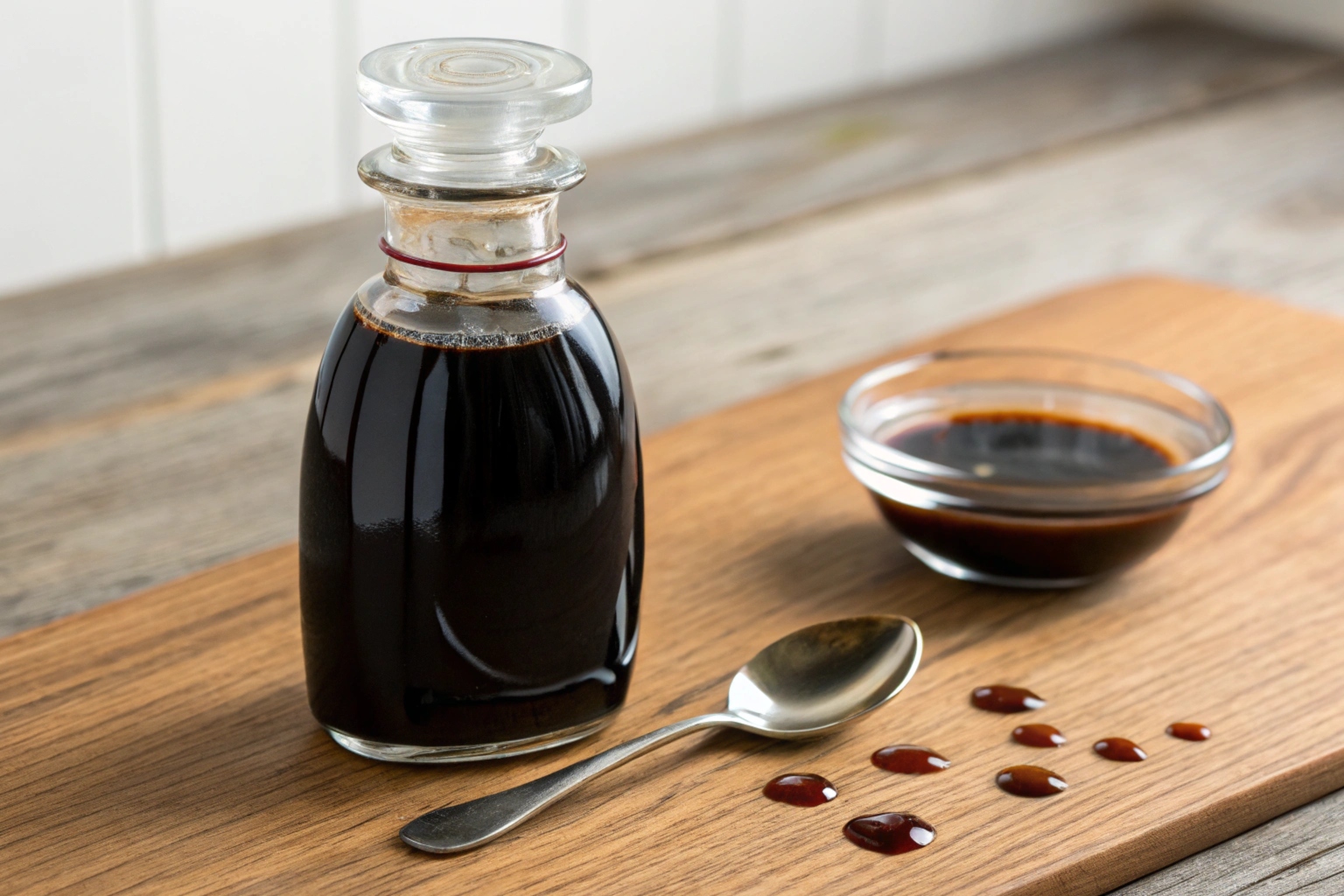Definition of Dark Soy Sauce
Dark soy sauce is a staple in Chinese cooking and other Asian dishes, renowned for its dark colour, richer flavour, and depth of flavor. Made through an extended fermentation process, this traditional soy sauce achieves its full-bodied color and unique taste by incorporating ingredients like palm sugar or molasses. Unlike its light soy sauce counterpart, it is thicker, sweeter, and used primarily to add depth of color and rich soy flavor to various dishes.
Originating in China, these sauces are integral in creating authentic Chinese recipes, balancing salty and sweet notes to enhance the darker colour and appeal of sauce in recipes. Popular brands like Lee Kum Kee Premium exemplify the high-quality options available today.
Differences Between Dark Soy Sauce and Other Sauces
Light Soy Sauce
Light soy sauce, often referred to as regular soy sauce, is lighter in both color and consistency. It serves as a dipping sauce and seasoning, ideal for accentuating flavors without altering the dish’s appearance. Unlike dark soy sauce, it doesn’t contribute to a rich color but provides a salty and slightly tangy taste. In contrast, it is primarily used for its ability to add a richer flavour and enhance the depth of color in Chinese dishes.
Tamari
Tamari, a type of Japanese soy sauce, is known for its gluten-free composition, making it a suitable alternative for individuals with dietary restrictions. Its thicker consistency and rich soy flavor share some similarities with dark soy sauce, but tamari lacks the characteristic sweetness derived from palm sugar or molasses found in dark sauces.
Shoyu
Shoyu, another Japanese soy sauce, typically offers a balanced profile of saltiness and umami. It’s more akin to light than dark soy sauce, used as a dipping sauce or to complement Japanese light recipes. Unlike dark soy sauces, shoyu does not contribute significantly to the depth of color in dishes.
Culinary Uses of Dark Soy Sauce
Enhancing Flavor Profiles
In Chinese cooking, dark soy sauce is revered for its ability to impart a sweet taste and umami richness. It’s often paired with a pinch of sugar to create sauces that balance salty and sweet elements seamlessly. Adding dark soy sauce to Asian dishes like braised meats or stir-fries elevates the overall flavor profile, creating a more cohesive and indulgent taste.
Color and Aesthetic Appeal
One of the hallmark traits of dark soy sauce is its capacity to lend a darker colour to dishes. The rich color enhances the visual appeal of dishes such as fried rice, noodles, and roasted meats, making them more appetizing. Its depth of color and full-bodied color are especially prominent in slow-cooked Chinese recipes.
How to Substitute Dark Soy Sauce
Oyster Sauce
When searching for a dark soy sauce substitute, oyster sauce offers a similar thickness and sweetness. Although it’s derived from oysters, its flavor complements many Chinese dishes. The addition of a pinch of sugar can help mimic the sweetness of dark soy sauce.
Coconut Aminos
Coconut aminos is another viable alternative, particularly for those seeking a gluten-free or soy-free option. While it lacks the darker colour and depth of flavor of dark soy sauces, it provides a mildly sweet taste that works well in a wide range of recipes.
Homemade Alternatives
Creating a homemade substitute involves mixing light soy sauce with molasses or palm sugar. This blend replicates the sweet taste and rich flavor characteristic of dark soy sauce. Adding a pinch of sugar can further enhance the sweetness if needed.
Ingredient Composition of Dark Soy Sauce
The ingredient list typically includes fermented soybeans, wheat, water, salt, and a sweetening agent like palm sugar or molasses. The fermentation process plays a crucial role in developing its signature richer flavour and dark colour. Some brands may include preservatives to extend shelf life, but traditional recipes rely on natural fermentation for optimal taste.
Popular Brands of Dark Soy Sauce
Brands like Lee Kum Kee Premium and Pearl River Bridge are well-known for their high-quality offerings. These brands ensure a balance of sweetness, saltiness, and umami, making them favorites among home cooks and professional chefs alike. Their consistent quality makes them indispensable for preparing authentic Chinese recipes and Asian dishes.
Dietary Considerations
Gluten-Free Options
Many sauces are made with wheat, making them unsuitable for individuals with gluten intolerance. However, brands like San-J and Kikkoman offer gluten-free alternatives that preserve the rich soy flavor and darker colour.
Keto Compatibility
For those following a keto diet, choosing a sauce with minimal added sugars is essential. Checking the ingredient list for hidden carbohydrates ensures compatibility with low-carb meal plans. Some brands specifically cater to keto-friendly cooking by reducing or eliminating sweeteners like palm sugar.
Tips for Storing
Proper storage ensures its longevity and flavor integrity. It should be kept in a cool, dark place, such as a pantry, and tightly sealed after each use to prevent oxidation. Refrigeration is recommended for extended freshness, especially for those who don’t use dark sauces frequently.
Conclusion
Whether enhancing a Chinese dish or exploring substitutions, this is an essential ingredient in achieving a rich color and depth of flavor in cooking. From understanding its origins to discovering creative ways to incorporate it into recipes, the versatility and culinary potential of dark soy sauce make it a beloved staple in kitchens worldwide.
read also: What does Calamari taste like

